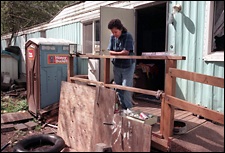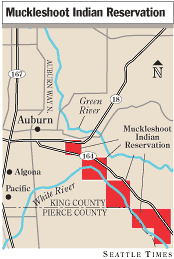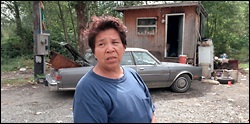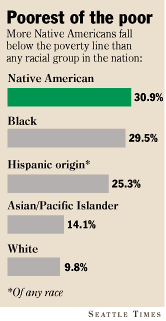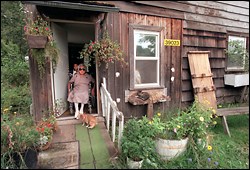 |
 |
 |
| Your account | Today's news index | Weather | Traffic | Movies | Restaurants | Today's events | ||||||||
|
December 1, 1996
HUD program undermined, while many remain in shacks
To stand outside it is to wonder how such dimensions — 10 feet by 12 feet — can enclose a life. To stand inside is to marvel at how much she has managed to fit in: a bed, a recliner, a television, a pile of clothes, a wall of pictures, a fan, a water jug, a hot plate. From the center of the room, she is a step away from almost every object in her house. But to use a toilet, she must step outside to a portable Sani-Can. For water, she must trudge across a littered yard to her son's trailer. For electricity, she must string together extension cords from the trailer to her house.
Moses' house is an example of what Indian-housing bureaucrats
call a "substandard" dwelling. Moses herself is more plain-spoken:
She considers herself lucky Moses, a Muckleshoot Indian, is a crinkly-eyed mother of nine and grandmother of 25 who considers herself lucky to have a house at all. She could be living under a bridge or in a car, like other Native Americans she has known. She has lived on the Muckleshoot Reservation for most of her 56 years. For the past 10, she's been waiting for a government-subsidized house. "I've been waiting so long, I'm a senior citizen now," Moses said. She's on a waiting list, like a hundred others in her tribe, like more than 5,000 others in the Pacific Northwest, and more than 100,000 around the country. Native Americans in tribal areas live in some of the worst housing conditions in the nation, with vast numbers living without running water, plumbing or electricity. Often, two or three generations live in dwellings designed for two or three people. With federal dollars shrinking and the Native-American population burgeoning, officials say the Indian-housing problem has reached crisis proportions. An estimated 40 percent of all Indians in tribal areas live in what are euphemistically called substandard dwellings. Housing officials say 100,000 new homes nationwide are needed now — never mind the coming decades.
The major source of money for housing on reservations is the
U.S. Department of Housing and Urban Development. Without HUD money,
it's virtually impossible to get a housing loan; banks generally
won't lend to reservation dwellers because the lender can't
foreclose on the land if a home loan goes into default.
Virginia Toews, a retired Indian-housing lobbyist living in Billings, Mont., explained it this way: "Let's say you were living on the Northern Cheyenne Indian Reservation, and you decided you didn't want to live in your one-room log cabin anymore, that you wanted to live like other people do. You go to a bank to make a loan to build a home. They'll ask what do you have to mortgage, what's going to guarantee this loan? Well, you can't mortgage trust land. You say, 'I have a job that pays $18,000 a year and a family of six. The bank will say, 'Sorry, buddy.' "
Enter HUD's Native-American- housing program. It's designed to
give Indians a chance to build and own decent homes by providing
low-cost financing for owner-occupied houses, as well as development
money for affordable rental units.
Unless things change, Moses and most of the others will have to wait indefinitely. Bleak picture in all regions The picture is bleak in every region of the U.S.: • In the southwest corner of Alaska, more than 2,000 Eskimo natives are on a waiting list for HUD housing. Scattered villages resemble shantytowns, with earthen-floor dwellings that have no plumbing or electricity. "The term most used to describe this region is 'Third World,' " said Norm Fancher, Indian-housing-authority director in Bethel. "If I had to pick one word to describe the housing need, it would be 'desperate.' " • On the Pine Ridge Reservation in South Dakota, the housing crisis prompted the Oglala-Sioux Tribe to declare a state of emergency last December. Housing-authority director Paul Iron Cloud said 4,000 new houses are needed immediately to alleviate severe overcrowding. Some families are living in their cars in hopes of staying warm against winter on the plains. • In upstate New York, at the Seneca Indian Nation, a quarter of the homes do not have water, sewer or heat. Nearly a hundred families are on a waiting list for a HUD home, and at least a hundred more are in need of homes but have not qualified to be placed on the official list. "Most people that come into our office need housing yesterday," said housing director Bernadette Harlan. • The Navajo Nation — the country's largest tribe — has declared its housing in a crisis state, with more than 20,000 families in need of homes in Arizona, New Mexico and Utah. Of the tribe's 30,000 existing houses, 80 percent lack plumbing, electricity and telephones. • In northeast Oklahoma, 1,000 members of the Cherokee Nation languish on a waiting list, and another 1,000 are waiting just to get on the waiting list. Said housing-authority Director Joel Thompson: "One year, we had a thousand people on our list; HUD gave us 25 houses. I figured it out: at that pace, it would take 42 years to meet the need, assuming no one else was added to the list. If I planted pine-tree seedlings, they would reach maturity and we could turn them into lumber for new houses in that period of time." Long waiting lists in Northwest
One need not look beyond the Northwest to find miserable
conditions. A survey by the Bureau of Indian Affairs in 1993 found
that 5,050 Native-American families in the Northwest were in need of
new homes, and bureau officials say the need today could only be
greater.
Among the Shoshone-Bannock Tribe in Idaho, the Klamath Tribe in Oregon, and the Lummi and Yakama tribes in Washington, at least 2,000 families are in dire need of new housing. On the Muckleshoot reservation, the only tribal area in King County, nearly 100 people await homes, including several of Thelma Moses' relatives. "We're all 'on the list,' as they say," Moses said. She found herself jobless and about to be evicted from an apartment two years ago when she bought the one-room cubicle, a structure intended as an entryway for a mobile home. She paid $400 for it and has called it home ever since. Mostly, she lives alone, but sometimes her children and grandchildren come over to watch TV and spend the night. When that happens, bodies are almost literally stacked one atop each other. Holidays are impossible. "I don't like Christmas in my shack," said Moses, who used the word "shack" with equal parts gratitude and self-mockery. "I get depressed. There's no room for a tree." Poverty on Muckleshoot land The Muckleshoot Reservation is 3,840 acres of hilly, mostly rural land between the Green and White rivers outside Auburn. It is home to 3,100 Native Americans, of whom 1,200 are enrolled members of the Muckleshoot Tribe. Hopes for the future rest heavily on the tribe's fledgling casino. But while it has provided 877 jobs for tribal members, the profits haven't yet brought housing or social services. The tribe plans to start those programs soon. The per-capita income on the reservation is $4,000; the average education level is 10th grade; the housing stock, according to former housing director Dale Curtis, is "the most dilapidated of any Washington tribe." Scattered along dirt roads are clusters of shacks and broken-down trailers, often connected to the water system via garden hoses. Rusty portable toilets sit between abandoned cars and appliances. Sandra Ross lives in a trailer with her four kids, ages 4 to 8. Part of the trailer is not habitable because of water damage. Some windows are broken and covered by cellophane. The home has no running water or plumbing. Electricity comes in through an extension cord connected to a neighbor's trailer. A portable toilet sits outside the front door. On this day, she cannot leave the house because her car has broken down. Her children crowd around a flickering television, eating cereal and drinking Coke. "I'm just trying to get the place livable for now," said Ross, who is saving part of her welfare checks to buy a refrigerator and a heater. "Winter's coming but I'm not thinking about it. I can't think about it. I'm just thinking about getting through today." Ross' sister, Laurie Ross, is in a similar situation, living in a roach-infested apartment in Auburn with her four children, the youngest 9 months old. In March, her 15-year-old daughter is expecting a baby, and three generations will live together in the apartment. Ross was high on the waiting list for a HUD home, and was excited about the plan to build 65 new HUD units on the reservation. But that plan was scuttled in September when HUD — spurred by inquiries from The Seattle Times — froze its $7 million grant to the Muckleshoots and began an investigation of how the money was being spent. In a sequence of events repeated in case after case nationally, the housing-authority executive director — in this case, a retired HUD official — made some bad business decisions and HUD failed to act on early warning signs. By the time HUD stepped in, the Muckleshoots already had spent more than a third of the development grant — $2.5 million — with little to show for it beyond sewers, high-priced architectural drawings and a single, over-budget model house. The investigation continues, and Laurie Ross waits. "I want to be a responsible person. I want to raise my kids, to break this cycle we're in," she said. "We were all so excited about getting a house. Now I feel fooled. To be promised something like that, and then to have someone come along and take it from you and then act as if it were nothing - it's hard."
Copyright © 1996 Seattle Times Company, All Rights Reserved.
|
|
||||||||||||||||||||||||||||||||||||||||||||||||||||||
seattletimes.com home
Home delivery
| Contact us
| Search archive
| Site map
| Low-graphic
NWclassifieds
| NWsource
| Advertising info
| The Seattle Times Company
